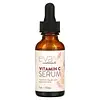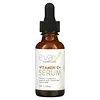What's inside
What's inside
 Key Ingredients
Key Ingredients

 Benefits
Benefits

 Concerns
Concerns

 Ingredients Side-by-side
Ingredients Side-by-side

Aloe Barbadensis Leaf
MaskingSodium Ascorbyl Phosphate
AntioxidantDimethyl Sulfone
SolventCassia Angustifolia Seed Polysaccharide
Skin ConditioningFerulic Acid
AntimicrobialCarbomer
Emulsion StabilisingArginine
MaskingUbiquinone
AntioxidantTocopheryl Acetate
AntioxidantGlycerin
HumectantJuniperus Communis Wood Water
Skin ConditioningLavandula Angustifolia Extract
Skin ConditioningZingiber Officinale Root
Skin ConditioningCurcumin
AntioxidantHamamelis Virginiana Water
AstringentSimmondsia Chinensis Seed Oil
EmollientPhenoxyethanol
PreservativeEthylhexylglycerin
Skin ConditioningAloe Barbadensis Leaf, Sodium Ascorbyl Phosphate, Dimethyl Sulfone, Cassia Angustifolia Seed Polysaccharide, Ferulic Acid, Carbomer, Arginine, Ubiquinone, Tocopheryl Acetate, Glycerin, Juniperus Communis Wood Water, Lavandula Angustifolia Extract, Zingiber Officinale Root, Curcumin, Hamamelis Virginiana Water, Simmondsia Chinensis Seed Oil, Phenoxyethanol, Ethylhexylglycerin
Water
Skin ConditioningDimethyl Sulfone
SolventSodium Ascorbyl Phosphate
AntioxidantNiacinamide
SmoothingSqualane
EmollientRosa Canina Fruit Oil
EmollientSalicylic Acid
MaskingPhenoxyethanol
PreservativeAcrylates/C10-30 Alkyl Acrylate Crosspolymer
Emulsion StabilisingPentylene Glycol
Skin ConditioningLecithin
EmollientGlycerin
HumectantSodium Hydroxide
BufferingMelaleuca Alternifolia Leaf Oil
AntioxidantLavandula Officinalis Flower Oil
PerfumingCananga Odorata Flower Oil
MaskingRetinol
Skin ConditioningPolysorbate 20
EmulsifyingEthylhexylglycerin
Skin ConditioningAlcohol
AntimicrobialTocopherol
AntioxidantPotassium Phosphate
BufferingCaesalpinia Spinosa Gum
Skin ConditioningPotassium Sorbate
PreservativeSodium Benzoate
MaskingCentella Asiatica Extract
CleansingGeranium Maculatum Extract
TonicEquisetum Arvense Extract
AstringentTaraxacum Officinale Extract
Skin ConditioningWater, Dimethyl Sulfone, Sodium Ascorbyl Phosphate, Niacinamide, Squalane, Rosa Canina Fruit Oil, Salicylic Acid, Phenoxyethanol, Acrylates/C10-30 Alkyl Acrylate Crosspolymer, Pentylene Glycol, Lecithin, Glycerin, Sodium Hydroxide, Melaleuca Alternifolia Leaf Oil, Lavandula Officinalis Flower Oil, Cananga Odorata Flower Oil, Retinol, Polysorbate 20, Ethylhexylglycerin, Alcohol, Tocopherol, Potassium Phosphate, Caesalpinia Spinosa Gum, Potassium Sorbate, Sodium Benzoate, Centella Asiatica Extract, Geranium Maculatum Extract, Equisetum Arvense Extract, Taraxacum Officinale Extract
Ingredients Explained
These ingredients are found in both products.
Ingredients higher up in an ingredient list are typically present in a larger amount.
Dimethyl Sulfone is an organic compound that naturally contains sulfur. It is used as a solvent due to its stability. Solvents help mix and stabilize other ingredients.
Studies show taking Dimethyl Sulfone (also known as methylsulfonylmethane) orally may help reduce the depth of wrinkles. We recommend speaking with a professional if you have any questions or concerns about this ingredient.
Ethylhexylglycerin (we can't pronounce this either) is commonly used as a preservative and skin softener. It is derived from glyceryl.
You might see Ethylhexylglycerin often paired with other preservatives such as phenoxyethanol. Ethylhexylglycerin has been found to increase the effectiveness of these other preservatives.
Glycerin is already naturally found in your skin. It helps moisturize and protect your skin.
A study from 2016 found glycerin to be more effective as a humectant than AHAs and hyaluronic acid.
As a humectant, it helps the skin stay hydrated by pulling moisture to your skin. The low molecular weight of glycerin allows it to pull moisture into the deeper layers of your skin.
Hydrated skin improves your skin barrier; Your skin barrier helps protect against irritants and bacteria.
Glycerin has also been found to have antimicrobial and antiviral properties. Due to these properties, glycerin is often used in wound and burn treatments.
In cosmetics, glycerin is usually derived from plants such as soybean or palm. However, it can also be sourced from animals, such as tallow or animal fat.
This ingredient is organic, colorless, odorless, and non-toxic.
Glycerin is the name for this ingredient in American English. British English uses Glycerol/Glycerine.
Learn more about GlycerinPhenoxyethanol is a preservative that has germicide, antimicrobial, and aromatic properties. Studies show that phenoxyethanol can prevent microbial growth. By itself, it has a scent that is similar to that of a rose.
It's often used in formulations along with Caprylyl Glycol to preserve the shelf life of products.
Sodium Ascorbyl Phosphate is a form of Vitamin C. It is the salt of ascorbic acid.
This ingredient is more gentle than ascorbic acid. It is also more stable when exposed to light and oxygen.
Vitamin C helps reduce redness, improve skin texture, reduce the effects of aging, reduce the visibility of dark spots, and brighten skin.
Your skin uses Vitamin C to produce collagen and collagen production plays a role in having a strong skin barrier and plump skin. As an antioxidant, this ingredient also helps reduce the signs of aging such as fine-lines and wrinkles.
VItamin C helps brighten skin by blocking the process of skin darkening.
In a 2011 study, Sodium Ascorbyl Phosphate was found to have antibacterial properties. This may help treat acne.
Read more about other types of Vitamin C:
Learn more about Sodium Ascorbyl Phosphate